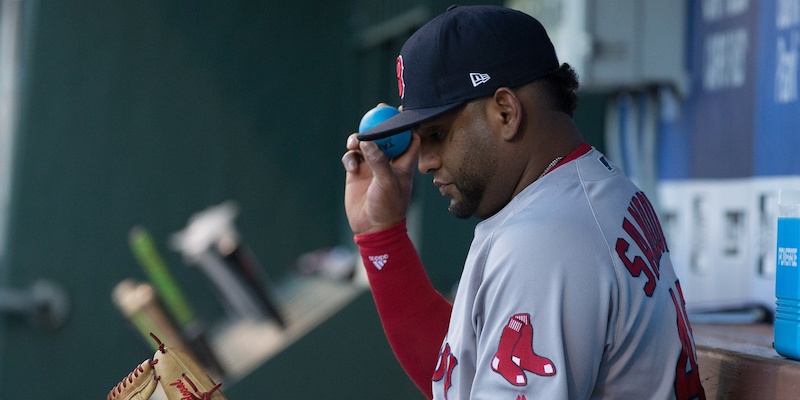It wasn’t too long ago that the Red Sox, needing to shed themselves of several mediocre third basemen, designated Pablo Sandoval for assignment. The five-year, $95 million deal barely got past the halfway point before the Red Sox ate over $40 million to cut him. You don’t need me to go into detail on how horrible that transaction was. It was even backloaded. That deal alone was pretty damning for Ben Cherington, and he was fired eight months later after the 2015 squad crashed and burned. It was a huge mistake, and that might be oversimplifying it a little bit.
But there’s good news, everyone! The Red Sox, if you haven’t heard, have lots and lots of money. $95 million spread out over half a decade isn’t all that much in the grand scheme of things to this ball club. In addition to a lucrative farm system that has recently developed some ready-made stars, the Red Sox profit from a massive fanbase and repeated successes to have one of the largest payrolls in baseball, one that rubs shoulders with the luxury tax threshold from time to time. This all might seem like me reciting things you already know in a slightly condescending tone, but I promise I’m going somewhere with this.
Think of all the big, awful contracts the Red Sox have had since the beginning of the decade. Carl Crawford, obviously. Josh Beckett’s extension is a plausible one. Daisuke Matsuzaka’s posting and deal were pretty bad. Hell, if you wanted to be really petty, you could say Julio Lugo’s four-year, $36 million deal was big and terrible due to the player they offered it to, and you’d have some compelling arguments. Looking back on those deals, could you honestly say any one of them crippled the short- or long-term future of the Red Sox? Probably not. Definitely not, if you consider the state of the payroll in 2017.
The Red Sox have effectively recovered from all their major contract screw-ups because they are a factory of money. It gives them a ton of leeway to make these huge deals in the first place. If those transactions don’t pan out, the torrent of cash that flows in allows the Sox to either cut those players and eat the money, or trade them away and still get something of value back, since they’re still paying a large percentage of the contract. Money gives the Red Sox a large margin of error, and the payroll can effectively tank the hit of a couple bad deals.
It isn’t just the exorbitant bidding in free agency that boxes out small-payroll teams – it’s the extreme regression risk that comes with any mega-deal.
This is the benefit of having a luxury-tax-pushing payroll that isn’t discussed very often. The inequality between the Red Sox and a team like the Rays or Athletics usually comes in the form of being able to make those deals. The Red Sox can price out those teams for any given player, if they felt compelled to do so. What isn’t talked about enough is what could happen after that deal is struck. A team like the Sox or Yankees can be saddled with a failure of a mega-deal (see: Ellsbury, Jacoby) and continue to compete and win. For the Rays and A’s, however, a player falling off on a huge deal would utterly cripple their short-term payroll and outlook, and might adversely affect their long-term plans. It isn’t just the exorbitant bidding in free agency that boxes out small-payroll teams, since deferments are a thing – it’s the extreme regression risk that comes with any mega-deal.
Pablo Sandoval would’ve earned an even $17 million this year. The Rays could fit Chris Archer’s, Kevin Kiermaier’s, Wilson Ramos’, and Corey Dickerson’s salaries into that with room to spare. The A’s would have wiggle room if you combined what Jed Lowrie, Yonder Alonso, and Rajai Davis are all getting paid in 2017 and shoved it in there. For those teams, having a player implode with $17 million attached to their name would deny them quite a lot of useful additions and potential trade chips. Now imagine losing out on getting good players on one-year deals – and the potential prospects that you’d receive by trading them – for four more years. That’s catastrophic at best, and a front office house cleaning at worst.
Sometimes, though, even the big payroll teams reach their limit. Burdened with Beckett’s contract extension, Crawford’s albatross contract, and the first year of Adrian Gonzalez’s extension, the Red Sox were hurting for salary relief. In a move that was the polar opposite of the Sandoval deal, Cherington offloaded all three of those contracts (plus Nick Punto) to the Los Angeles Dodgers, and while the prospects they received didn’t amount to much, getting over $250 million of salary off your books is still pretty damn good. The Red Sox were saved from a decade of payroll crunches due to a very shrewd waiver trade in August. They found the limits of the margins their money made for them.
This isn’t something that should be touted, honestly. It’s more of an unspoken benefit, a representation of the disparity in revenue between some of the teams in baseball. That kind of money allows for teams to not just go out and get players they want, but to make mistakes, and quickly recover from them. Sometimes big contracts work, and sometimes they don’t. The difference here is that when they don’t, the Red Sox can deal with it.

The flipside is that all that money seems to inevitably turn GM’s brains to mush. That, or having to deal with win-now owners who start shouting at inopportune times.